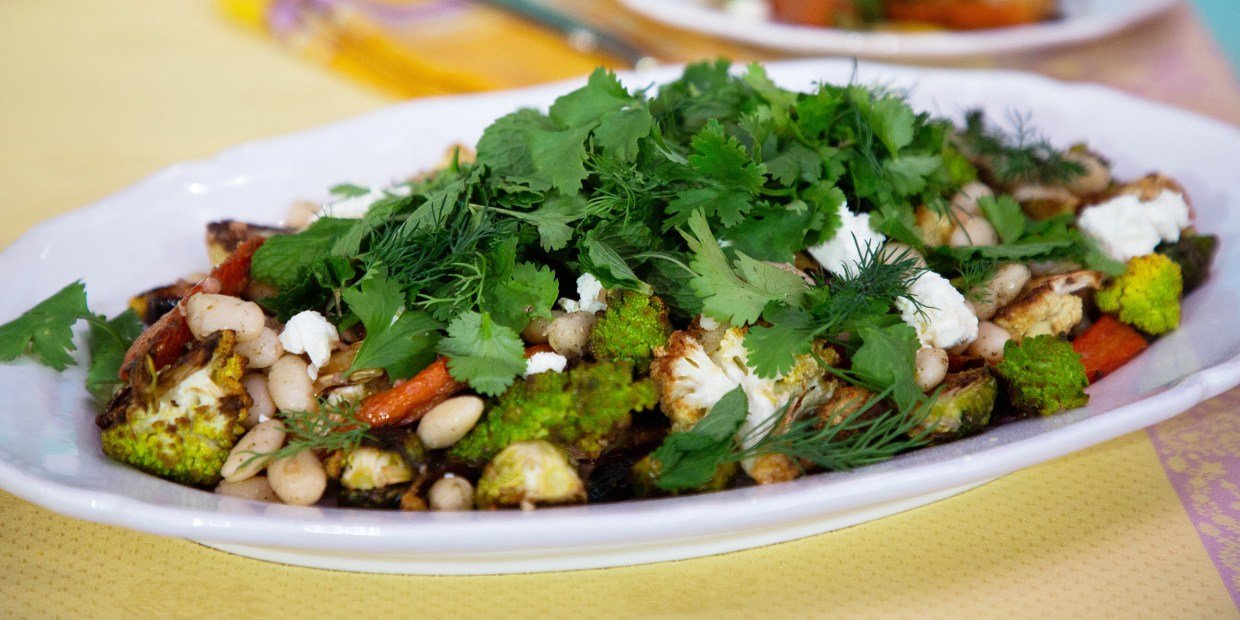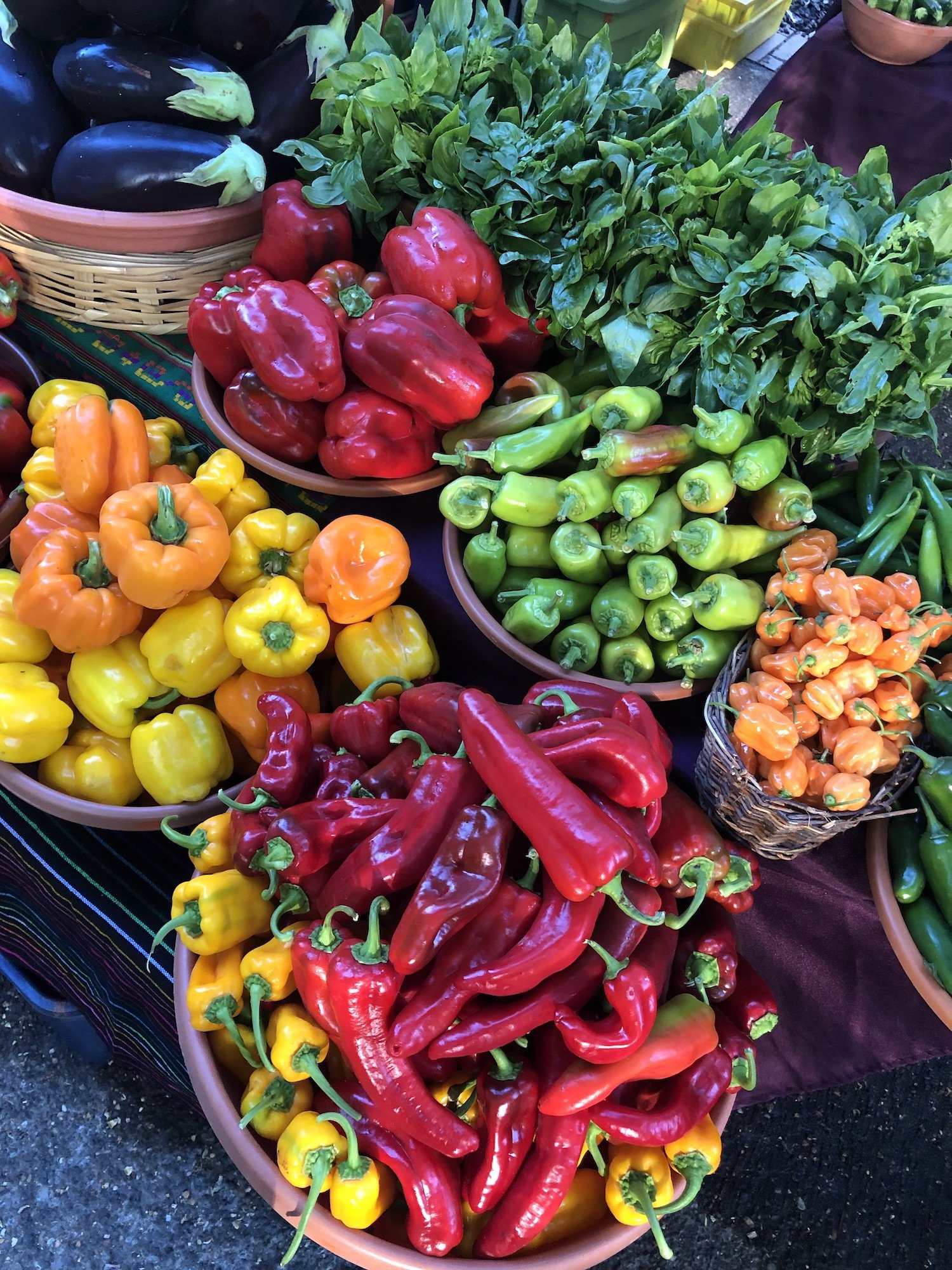
Peppers
Capsicum annuum
Sweet Bells and Italians alongside green chile de agua y habaneros from Eloisa Organic Farm
—Portland State University Farmers Market, July 2021
• Pepper 101 • Pepper Index • Recipes • Digging Deeper: Pepper Harvest •

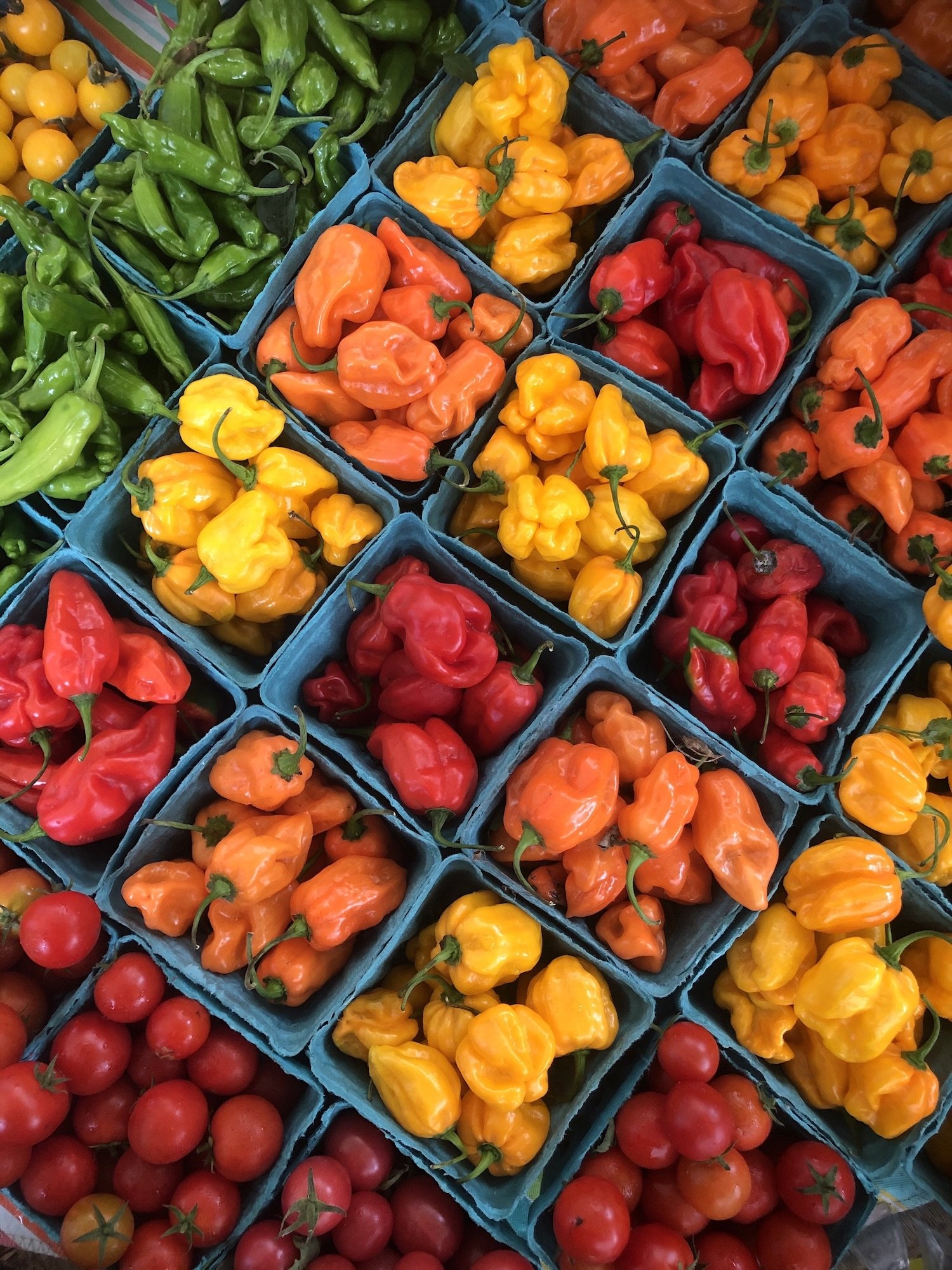

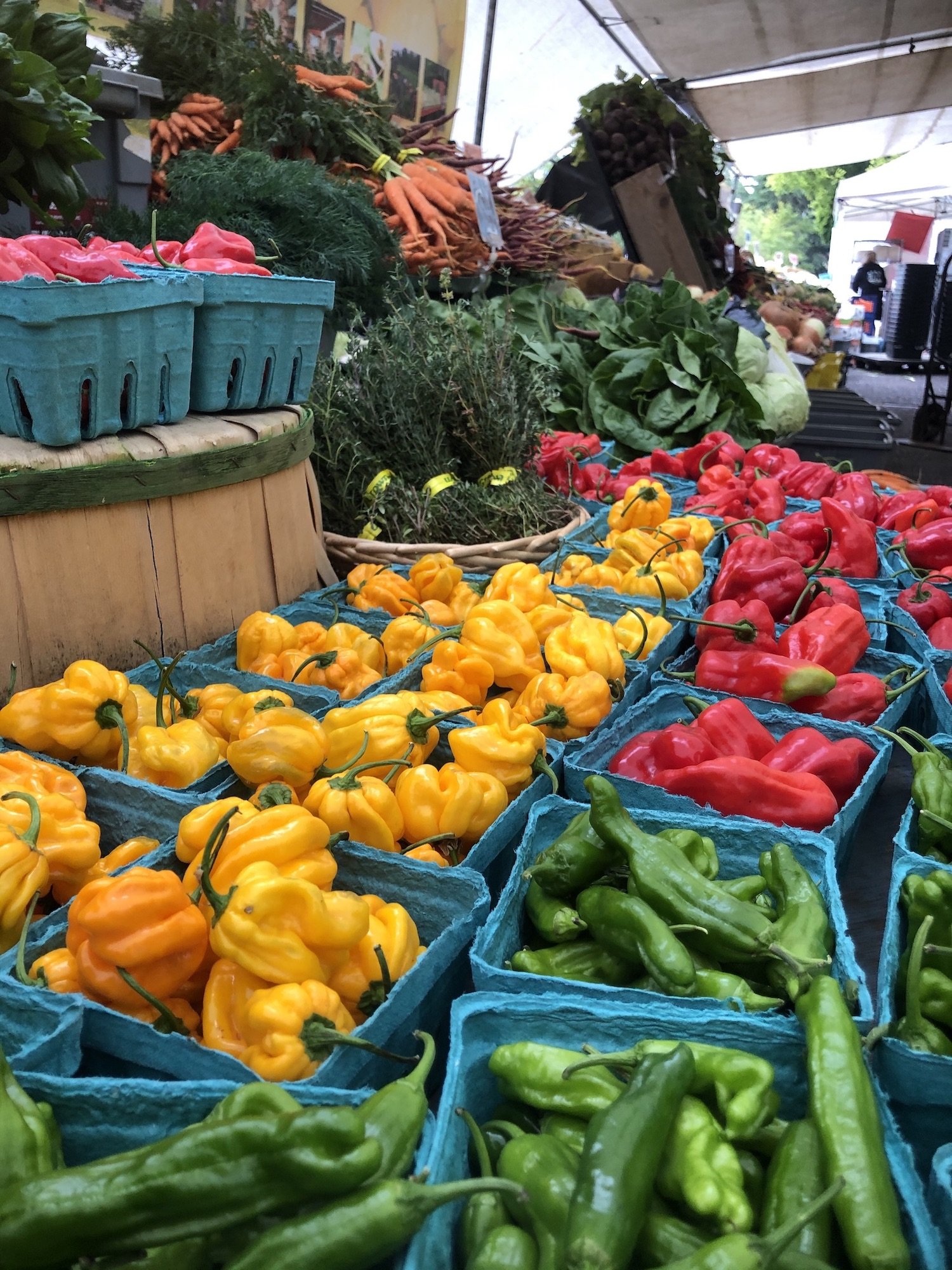

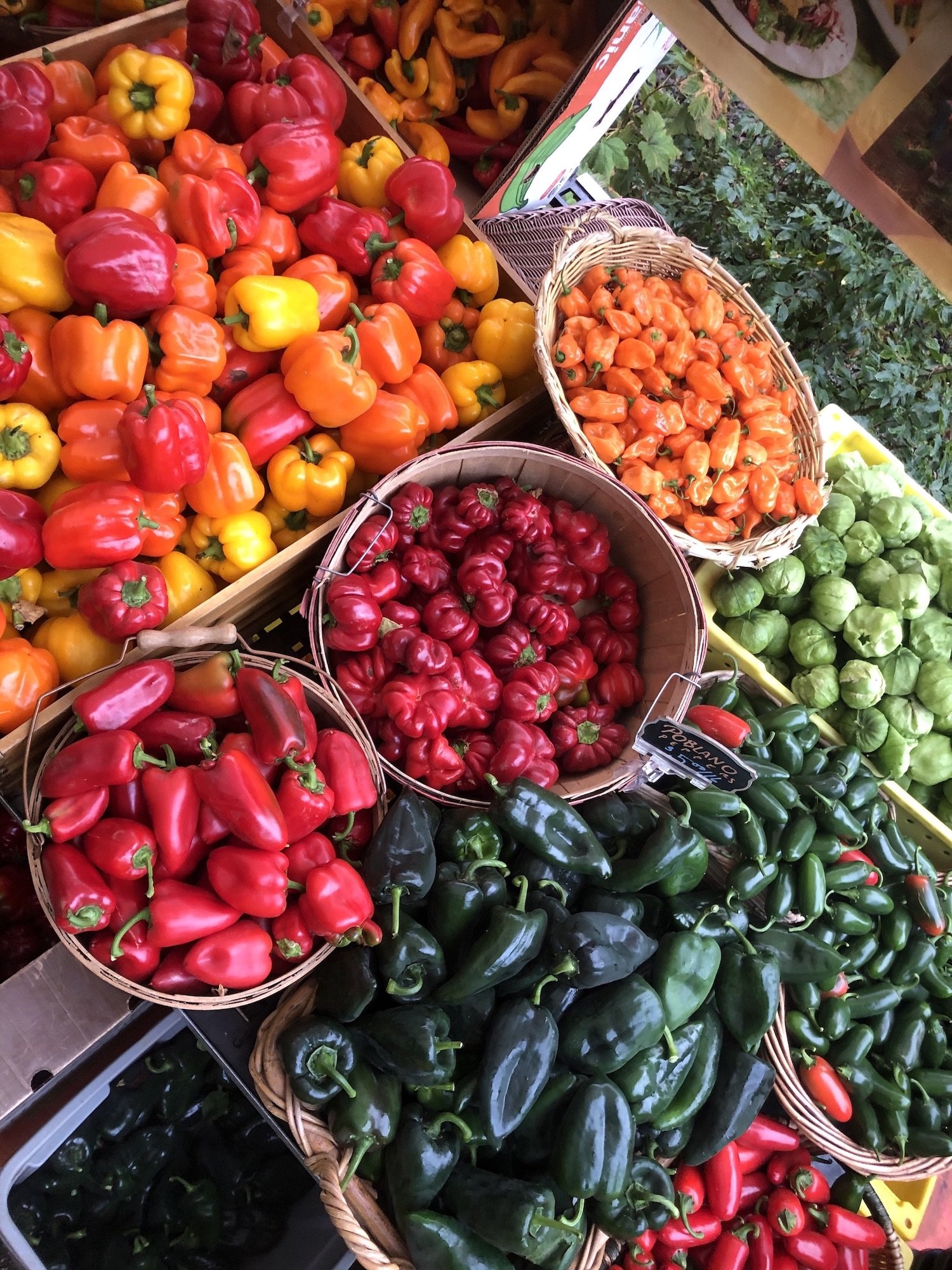

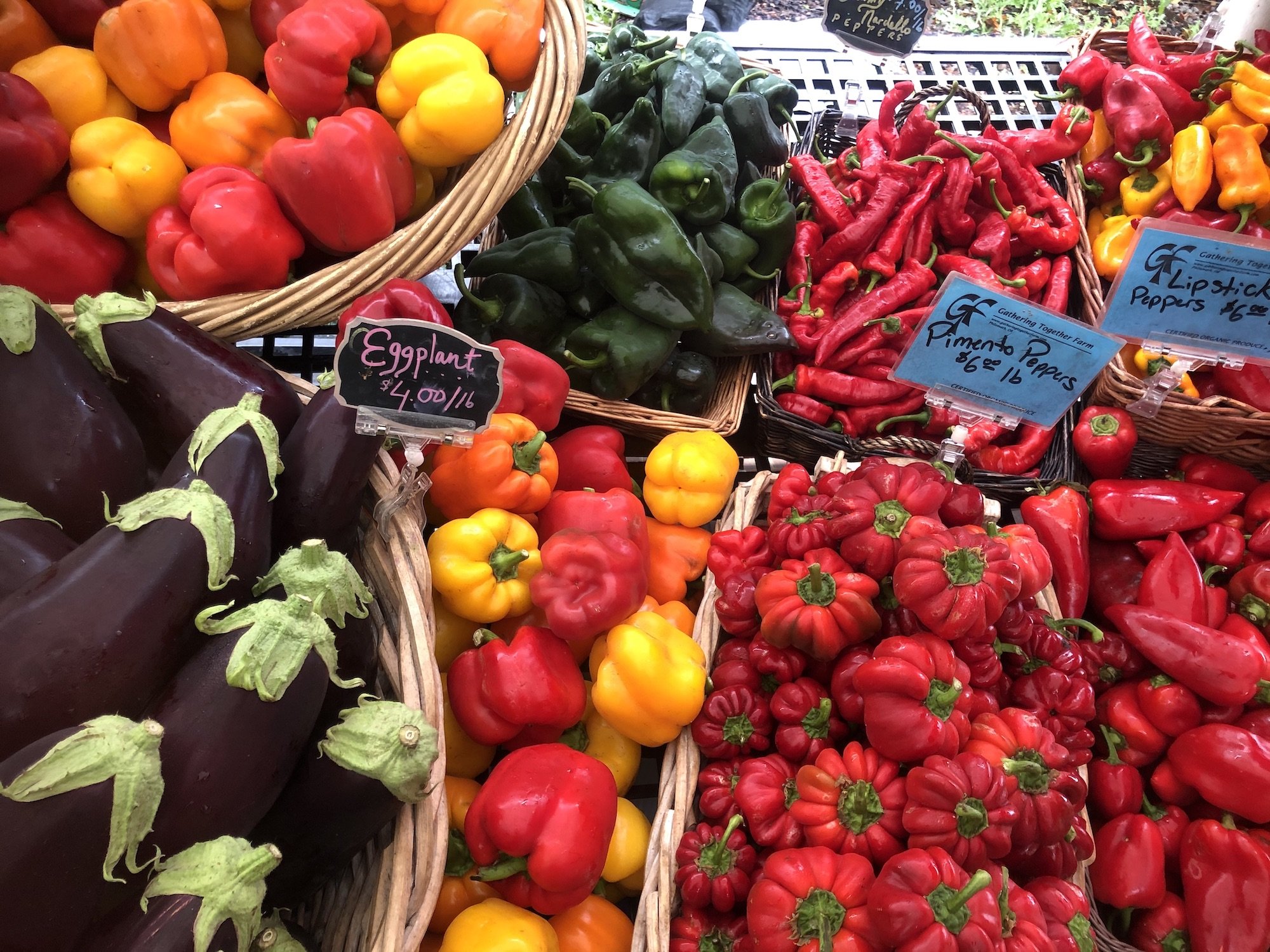
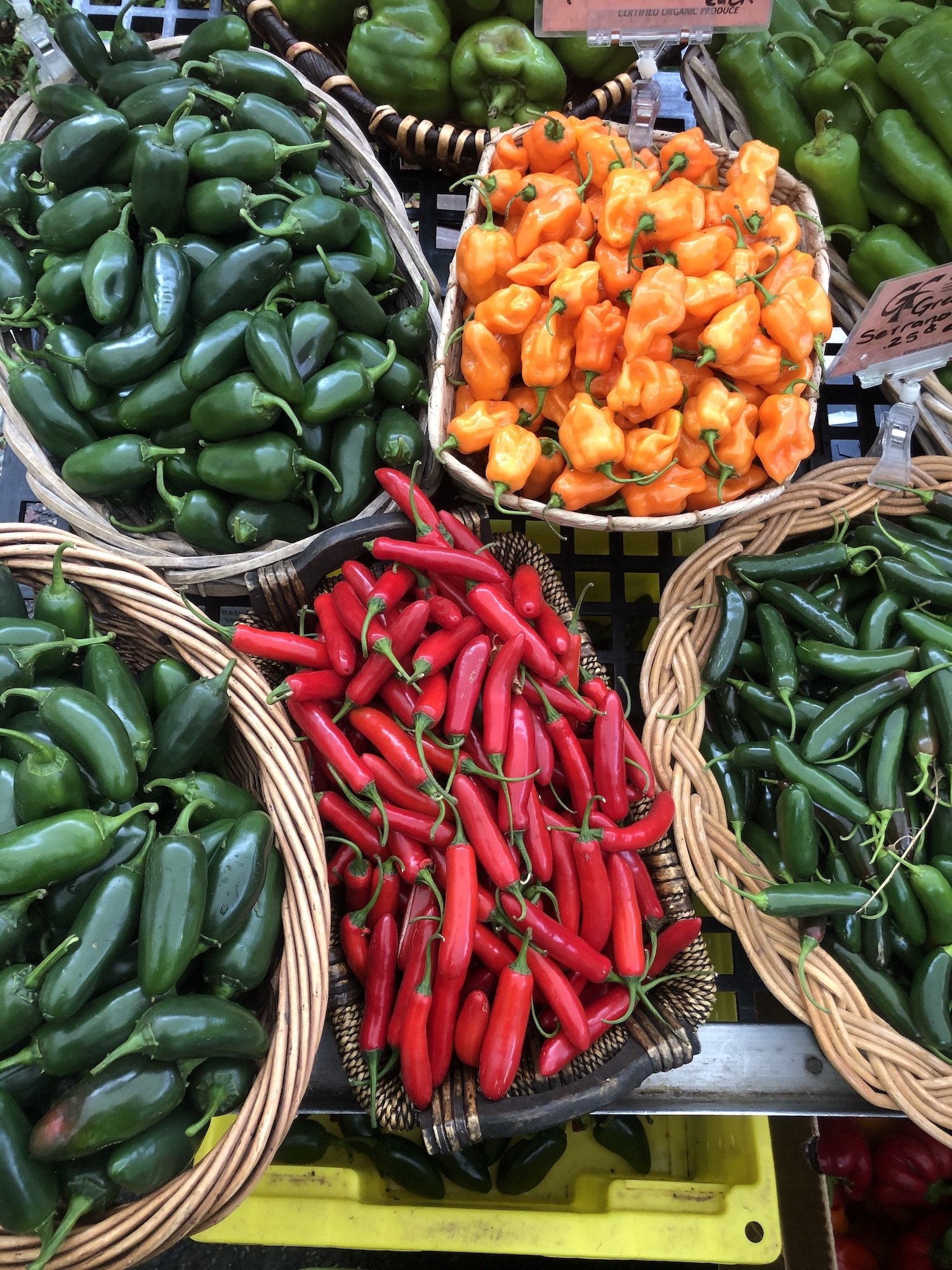
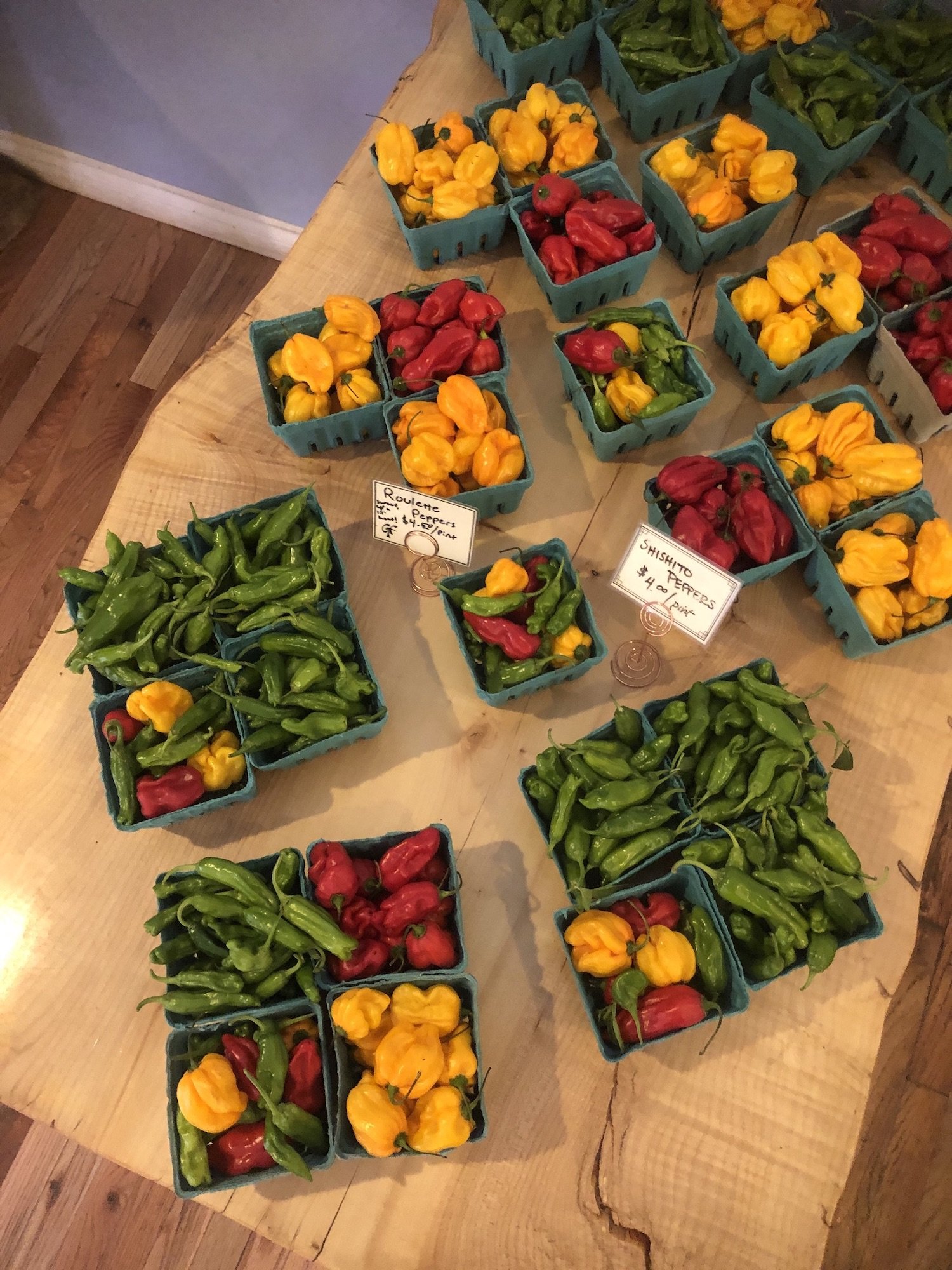
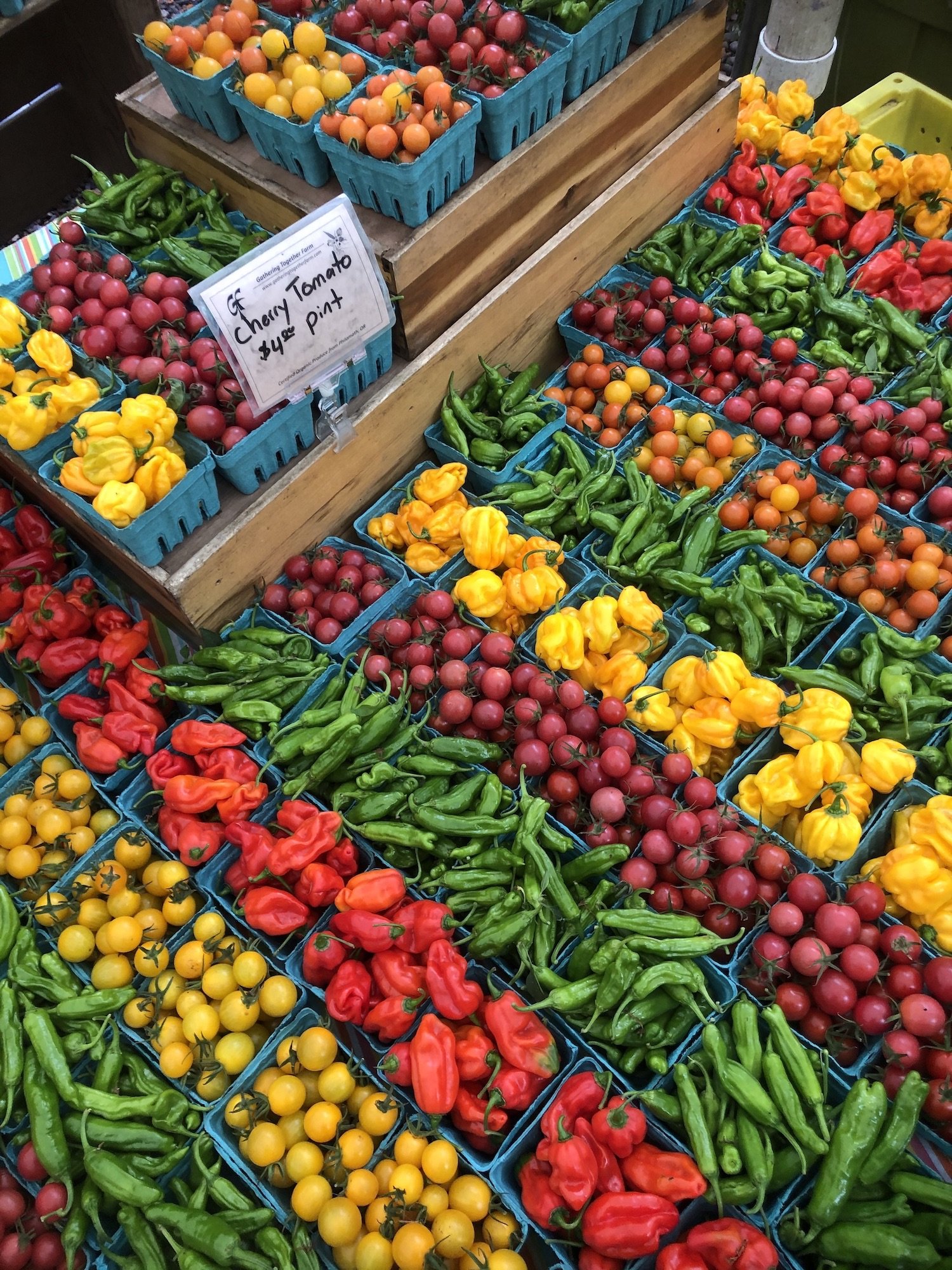
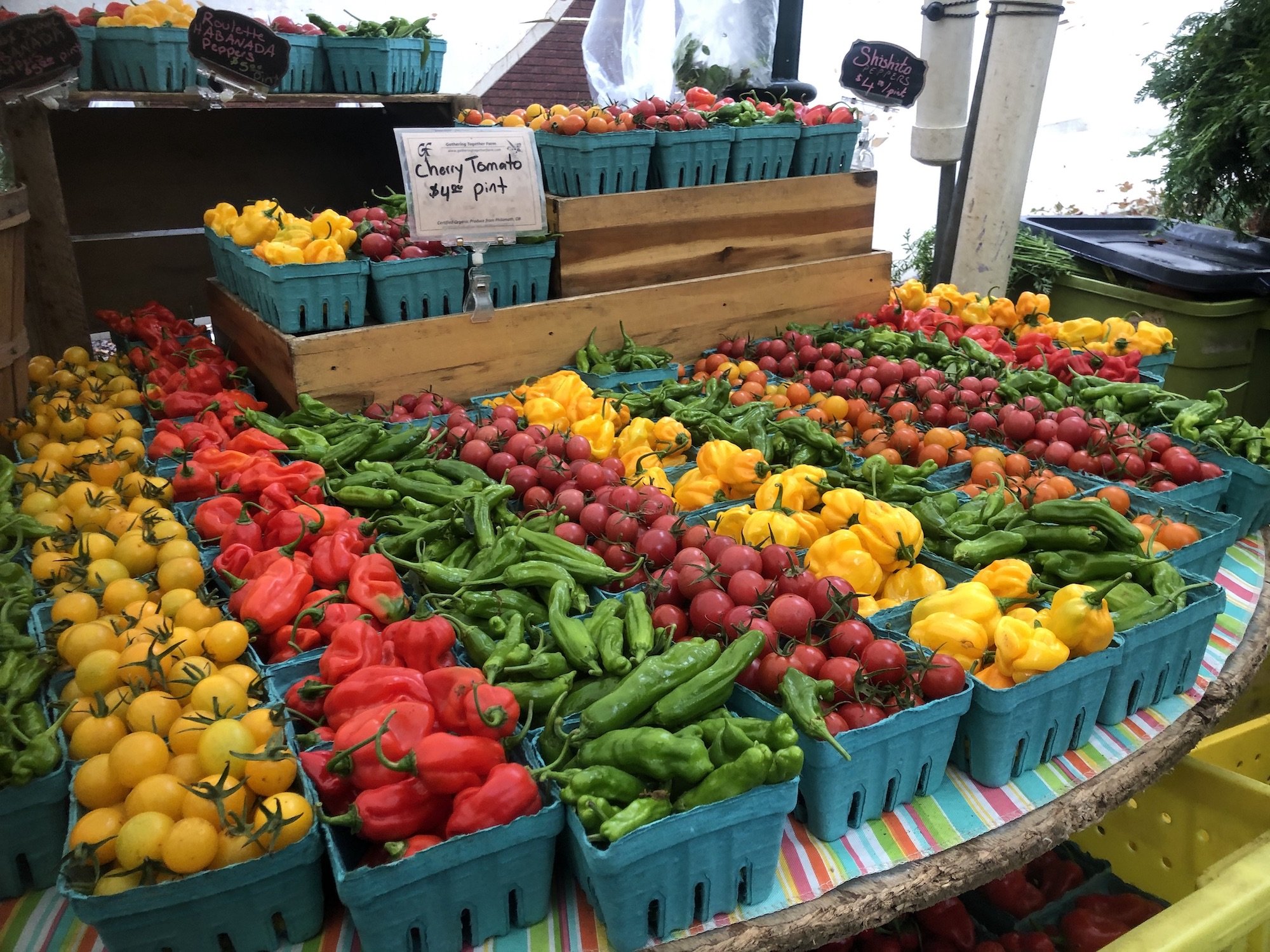



Pepper 101
Shiny, bright, almost plastic-toy-looking peppers are whatever you want them to be, from sweet and crisp sweet bells to hot peppers of all kinds that range from spicy to actual fire.
First and foremost, peppers or chiles, are from the hotter regions of the Americas, primarily in Central and South America but also in southern parts of what is now the United States. But pepper popularity spread around the world like rapid fire resulting in an exponential diversification of pepper varieties. Today there are over 4,000 distinctly different and commonly used varieties that are beloved around the world.
Throughout the entire process of curating this here Vegucation Station, attempting to categorize a comprehensive list of peppers was the most challenging task by far. The index below represents just thirty-six beloved peppers from around the world, the result of a heart-wrenching rollercoaster of selection and decision-making that defined a few weeks of my life, and I’m still a little upset that it’s not more inclusive.
What I ended up with was five general categories of peppers: sweet, mini poppers that are meant to be eaten whole in a single bite, warm peppers, spicy peppers, and peppers whose capsaicin levels have reached a level of heat that I just called fire. And as always on this site, this index works to include varieties that are commonly used around the world, but leans heavier on what is more available in the Pacific Northwest of the United States where my individual experience is based.
Peppers vs. Black Pepper
The black peppercorns that have become a staple alongside salt have absolutely no relation to chili peppers, but the confusion between the two was purposefully planted, brought to us by—you guessed it!— colonialism.
In the 1400’s, black pepper, grown in India and known in Europe as pimienta, was very popular in European cooking, but politics and impeded trade routes were making it difficult to source. In 1492 when Christopher Columbus made his way to the New World on the coast of what is now known as Haiti and the Dominican Republic, he experienced chili peppers for the first time and noted their similarity in spice to black peppercorns. The Indigenous Taíno people grew and knew the peppers as aji, but colonizers looking to make money off a potential replacement for peppercorns and control of the spice market used the same name for the aji peppers that they used for peppercorns as a marketing trick. Read more in Why Is a ‘Pepper’ Different From ‘Pepper’? Blame Christopher Columbus from Gastro Obcura.
While Indigenous Taíno people called their peppers ajis, the Aztecs used the word chili or chile based off a Nahuatl word. Many of the increasingly Indigenous and Latino farmworkers in Oregon and throughout the United States either still speak Indigenous languages such as Nahuatl, Mixteco, and Mam, or remember their family speaking it. In Guatemala alone there are 23 Indigenous languages remaining still spoken today.
Cooking with Peppers
With so many different kinds of peppers, of course you’ll need to use them in different ways. Peruse the resources and Pepper Index below to explore how peppers are celebrated on the plate around the world and how you can easily incorporate them into your cooking at home.
RELATED RESOURCES
A Beginner's Guide To Mexican Dried Peppers | Mexico in My Kitchen
A Brief History of Chili Peppers | Legal Nomads
A Guide to Chiles from Mexico: Which Is Más Caliente? | Familia Kitchen
What Defines Sichuan Cuisine - Spicy Bean Paste (Doubanjiang) from Liziqi (YouTube)
The Hot Pepper List: Know Your Spice | Pepper Scale
If you’re unfamiliar with the true history of the Americas that is not the highly incorrect, harmful, and whitewashed version we all learned from textbooks, a good place to start is John Leguizamo’s brilliant Latino History for Morons on Netflix, very funny & informative.

Digging Deeper — Harvesting Peppers in the USA
On Labor—Local & Conventional
Regardless of whether you get your peppers from the grocery store or from a local organic farm, an immense amount of labor is required to bring them from farm to table. A skilled professional produce harvester takes years of experience and shoves them into a millisecond where they ask themselves—is this pepper ready to pick? Is it rotten? Is it underripe?
The videos below highlight the conventional pepper harvest operations in the United States that supply our grocery store shelves and I want to make one distinction clear.
Many people who value buying local organic produce do not want to support the conventional systems that depend on cheap migrant labor, but the situation is much more complicated than that for two big reasons:
Cheap migrant labor is still the leading labor force on small, local, organic farms, and despite some better working conditions, the experience of farmworkers on small organic farms differs very little to those on conventional operations. Organic certification has nothing to do with labor rights, immigration reform, or the systemic racism in local and conventional ag. alike.
Most alternative food systems are only accessible to a small, predominately white and wealthy population, and so even when we do only shop at local farmers markets, we really aren’t doing anything to change the enormous conventional farming systems that the majority of people in the United States are stuck producing and consuming within. Action on the federal level is needed.
So all of that is to say, if you shop local, do not assume that these videos don’t apply to you, because they do. This is our food system in the United States, and we are all a part of it.
Banana Pepper Harvest in United States
Bell Pepper Harvest in The United States
Jalapeño Harvest in The United States
A Round of Applause for our Farmworkers!
Despite how difficult this work is, people take immense pride in what they do and are incredible skilled, professional farmers. A huge round of applause for all the mothers, fathers, friends, and children who work in the fields to stock our grocery store shelves. This is some of the hardest, unseen, and most important work in our society. Everyone has to eat.
Would you Harvest?
After watching some of these videos, ask yourself—would you do this type of work? For less than minimum wage? With no insurance and no benefits with no overtime pay, likely experiencing some level of harassment or assault with no way of speaking up for yourself, year after year after year, so that you could take care of your family? Why not? If you wouldn’t, why should anyone have to? And if anyone had to, why would the very decedents of the Indigenous people who bred these peppers into existence have to? Why would Indigenous people be relabeled as “illegal immigrants,” making it impossible to speak up against illegal working conditions in fear of deportation? Who benefits from a system set up this way?
These are the questions we should be asking ourselves as eaters. With nourishment comes responsibility, and we are responsible for the wellbeing of all people in our food system.
Food ActivisM Includes:
✅ Support Immigration Reform
✅ Pay attention to your state’s legislation calendar
✅ Call & Email your representatives regularly
✅ Follow & Support your local Farmworker Union
Pepper Index
Out of all the groups of edible Solanaceous plants, peppers are by far the most diverse, so diverse in fact that this rather comprehensive index is not able to fully capture even half of the peppers that exist. Below are some of the most common peppers used in cooking around the world. For more complete lists & scoval ratings peruse the following sites.
-
The Hot Pepper List: Know Your Spice | Pepper Scale
A Beginner's Guide To Mexican Dried Peppers | Mexico in My Kitchen

Sweet Peppers
There’s nothing like a crisp sweet pepper in the middle of summer. Whether you enjoy them raw like an apple, chopped up fresh into a salad or slaw, cooked into a stir-fry or roasted and blended into a sauce, sweet peppers are where it’s at.
-

Bells
These big bells are a classic, ranging from red to orange to yellow to purple, they vary in sugar content but are all incredibly crisp and refreshing. Reds are the sweetest. Green bell peppers are just unripe.
-

Italians
These elongated red and yellow peppers have a very high sugar content and particularly thin skins. They can be roasted up very quickly and the skins removed with ease if making romesco sauce.
-

Pimentos
The queen of sweet, pimento peppers have super thick, crunchy walls and the highest sugar content of all the sweet peppers. Pimentos come in many shapes, including ruffled and a stout Italian shape.
-

Jimmy Nardello
This tricky sweet treat looks very similar to cayenne peppers but is much larger, more rumply, and has slightly thicker walls. Incredible flavor in sauces and sautées.
-

Banana
A super mild and sweet little pepper that comes with a slight tang even without being pickled like a pepperoncini. Often served with sandwiches or in salads or sliced into stir-fries. Photo - Pepper Scale
-

Pepperoncini
AVG SHU: 300. Known for being pickled, sliced, and served with sandwiches, these small sweet peppers are a treat and come with a slightly warm heat. Photo — Pepper Scale

Mini Peppers
Although there are a very many tiny pepper in this world that will set your tongue on fire, the “Mini Peppers” in this group are sweet to mild and are meant to be eaten whole with ease. While shishitos and padrons tend to be more common at the farmers market, the range of super sweet, tropical, heatless habaneros are hot on the scene! I love to toss all the different colors of peppers into a frying pan with oil and serve with a sprinkle of salt on a very special gorgeous platter (or eat them all to myself alongside eggs for breakfast).
-

Shishitos
AVG SHU: 125
These heatless thin-walled little green peppers have made their mark on farmers markets, perfect for tossing a hot pan with a little oil and salt and enjoying whole. Great for breakfasts & camping trips.
-

Padrons
AVG SHU: 1500
Unlike shishitos, padrons usually carry a little to occassionally a lot of warmth. Padrons can be cooked and eaten whole the same as shishitos, but with a little bit of caution.
-

Habanada
AVG SHU: 0
These bright orange, pointy-tipped peppers may look like a habanero but they are totally heatless with the most incredible sweet, tropical flavor. Shishitos who? An absolute must try.
-

NuMex Suave
AVG SHU: 665
These slightly larger yellow lanterns are another heatless habanero with an incredible sweet tropical flavor, along with a whisper of habanero heat. Larger plant, produces well in temperate climates.
-

Roulette
With a name like roulette one is sure to proceed with caution, but these too are completely heatless little pepper poppers with a more mild tropical sweetness. Mix with your other heatless habs!
-

Tangerine Dream
AVG SHU: 0
This almost-ornamental pepper grows its fruits upwards and has a super sweet tropical flavor with thick juicy walls, perfect for snacking. Photo—Pepper Scale
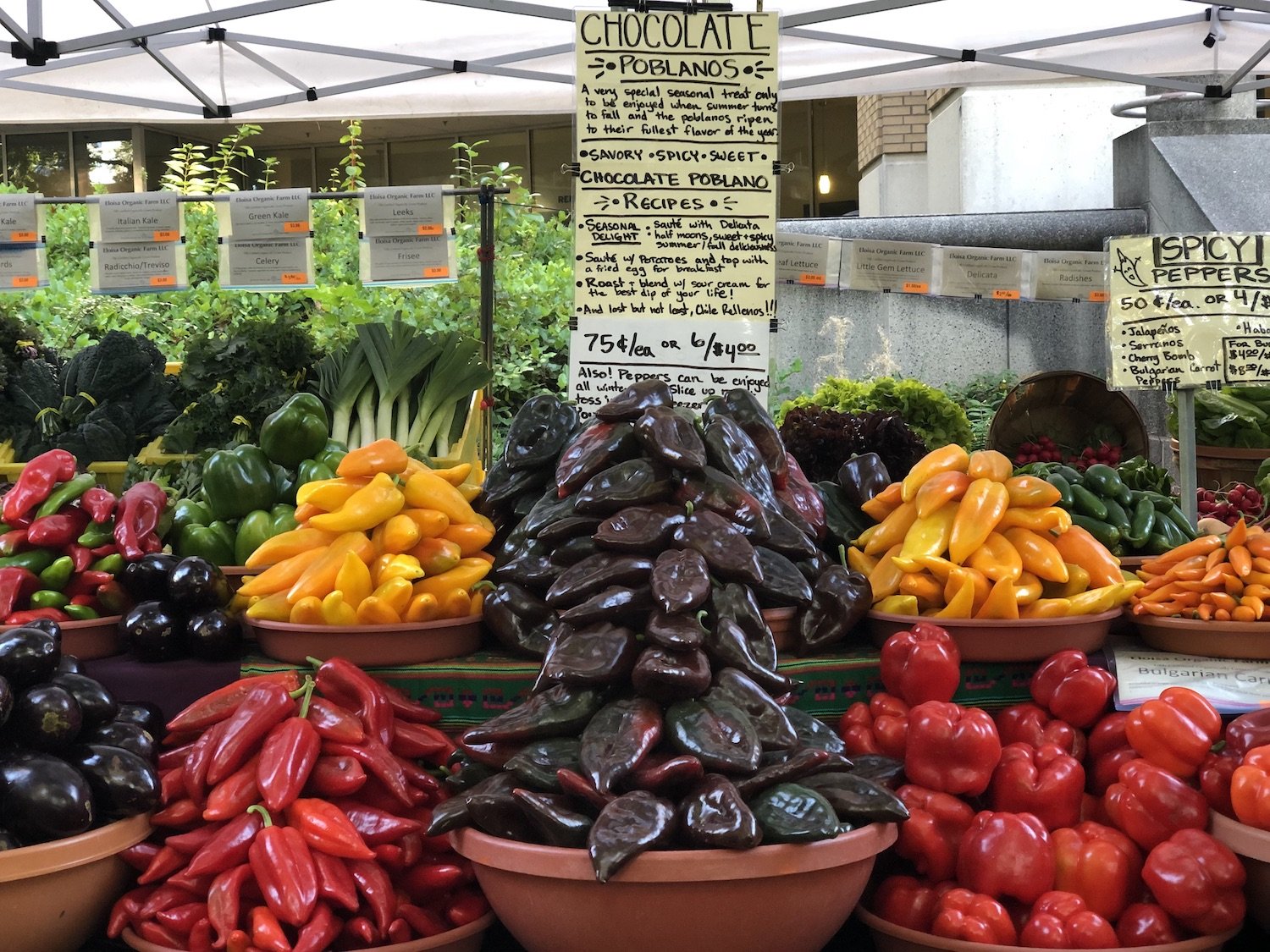
Warm Peppers
These peppers are known for have a rich savory flavor and a hint of heat that warms you up. Harvested and eaten both green while the peppers are still pretty mild in addition to when ripened to their full red color and heat.
-

Cubanelle
AVG SHU: 550
Photo - Pepper Scale
-

Poblano
AVG SHU: 1250
-

Anaheim
AVG SHU: 1500
-

Pasilla
AVG SHU: 1750
Photo — Isabel Eats
-

Guajillo
AVG SHU: 3750
Photo — Isabel Eats
-

Chile De Agua

Spicy Peppers
These peppers tend to be smaller in size with a much higher heat content that is to be approached with caution. Jalapeños are pretty mild as far as spicy peppers go, explore 12 common spicy peppers in order of increasing Scoville Heat Units.
Note: All Scoville heat ratings are an average, but actual SHU levels vary depending on climate and varieties.
-

Bola/Cascabel
AVG SHU: 2,000
Photo — Pepper Scale
-

Cherry Bomb
AVG SHU: 3750
-

Jalapeño
AVG SHU: 5250
-

Fresno Pepper
AVG SHU: 6,250
Photo — Pepper Scale
-

Serrano
AVG SHU: 16,500
-

Bulgarian Carrot
AVG SHU: 17,500
-

Chile de Arbol
AVG SHU: 22,500
Photo: Kids are Great Cooks
-

Chile Piquín
AVG SHU: 37,500
Photo—Mexico in My Kitchen
-

Tabasco Pepper
AVG SHU: 40,000
Photo — Baker Creek
-

Aji Amarillo
AVG SHU: 40,000
Photo — Pepper Scale
-

Cayenne
AVG SHU: 40,000
Photo — Baker Creek
-

Thai Pepper
AVG SHU: 75,000
Photo — Izzy Cooking

Fire
A jalapeno at 5000 SHU isn’t anything compared to a pepper who’s Scoville heat rating is in the millions. These peppers can actually be dangerous if not handled with care, but they are the secret ingredient to many hot sauces and other dishes.
For reference, pure Capsaicin has an SHU of 15 million, and Pepper Sprays used for self defense range from 2 to 5 million. The Carolina Reaper is the official hottest pepper in the world. Although others have surpassed its heat, their stability as a variety is still not there, meaning that from pepper to pepper the level of heat varies too much to be officially hotter.
-
Habanero
AVG SHU: 225,000
Although incredibly hot, this pepper has such a lovely tropical twist that makes for delicious salsas. Caribbean Red Habaneros are even hotter with a max SHU of 445,000.
-

Scotch Bonnet
AVG SHU: 225,000
Photo — Pepper Scale
-

Ghost Pepper
AVG SHU: 948,200
Known as Bhut Jolokia in India and translated to “Ghost” Pepper, this super-hot pepper’s heat sneaks on you, building hotter over a long period of time. Photo — Pepper Scale
-

Trinidad Moruga Scorpion
AVG SHU: 1,600,000
Photo — Pepper Scale
-

Carolina Reaper
AVG SHU: 1,800,000
How This Guy Made the World's Hottest Peppers | Obsessed | WIRED (YouTube)
Photo — Pepper Scale
-

Dragon's Breath
AVG SHU: 2,480,000
Bred in the UK in attempt to develop peppers that would provide capsaicin used for alternative anesthetics. Not for eating. Photo - Pepper Scale







